Pump Handbook by Igor J. Karassik, Joseph P. Messina, Paul Cooper, Charles C. Heald - 3rd edition
Подождите немного. Документ загружается.

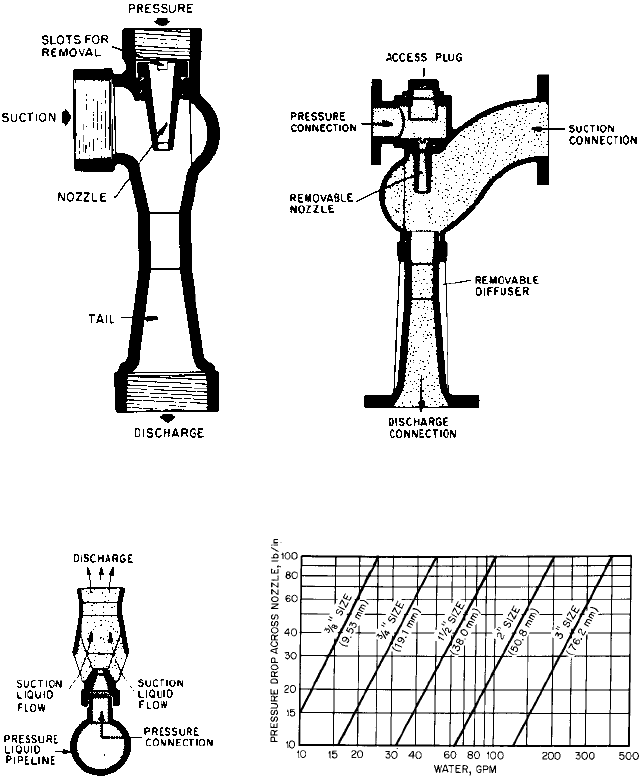
4.2 JET PUMP APPLICATIONS 4.33
FIGURE 6 General purpose eductor
(Schutte and Koerting)
FIGURE 7 Streamlined eductor (Schutte and Koerting)
FIGURE 8 Sparger nozzle (Schutte
and Koerting)
FIGURE 9 Motive flow rate of Sparger nozzles (gpm 0.227 =
m
3
/h; lb/in
2
0.0689 = bar) (Schutte and Koerting)
minimizes the expansion effect of flashing vapor. Sizing is done in the manner illustrated
in Example 1, using Figures 3 and 4.
MIXING EDUCTORS Although any eductor is inherently a mixing device, some are specifi-
cally designed as mixers. They are used to replace mechanical agitators and are located
inside the tank containing the fluid to be agitated. Figure 8 illustrates the simplest type
of eductor, the Sparger nozzle. These units entrain a volume of suction fluid that is approx-
imately three times the volume of motive fluid. A 20-lb/in
2
(1.4-bar) drop across the noz-
zle is recommended for proper mixing. Figure 9 shows the motive flow rates for this type

4.34 CHAPTER FOUR
TABLE 2 Motive flow rates of tank mixing eductors, gpm
a
Pressure difference, inlet to tank, lb/in
2
(bar) gage
Size, in 10 20 30 40 50 60 80 100
(mm) (0.69) (1.4) (2.1) (2.8) (3.4) (4.1) (5.5) (6.9)
(12.7) 3.5 5.0 6.0 7.0 8.0 8.5 10.0 11.0
(19.1) 10.0 14.5 17.5 20.0 23.0 24.5 29.0 32.0
1 (25.4) 14.2 20.0 25.0 28.0 30.0 34.5 40.0 44.5
1 (31.8) 22.0 31.0 37.5 44.0 50.0 53.0 62.5 69.0
1 (38.1) 31.5 45.0 54.0 63.0 72.0 76.5 90.0 99.0
2 (50.8) 56.0 80.0 96.0 112.0 128.0 136.0 160.0 176.0
3 (76.2) 126.0 180.0 216.0 252.0 288.0 306.0 360.0 396.0
4 (102) 224.0 320.0 384.0 448.0 512.0 544.0 640.0 704.0
5 (127) 350.0 500.0 600.0 700.0 800.0 850.0 1000.0 1100.0
6 (152) 494.0 720.0 864.0 1008.0 1152.0 1224.0 1440.0 1584.0
a
gpm 0.227 m
3
/h
Source: Schutte and Koerting.
1
2
1
4
3
4
1
2
of eductor. Sparger nozzles are normally used for shallow tanks, whereas the following
tank mixer described is preferred for deeper vessels.
Figure 10 illustrates a type of eductor called a tank mixer. It is installed under the tank
containing the fluid to be agitated. Motive capacities are shown in Table 2. The units are
usually custom-designed for a specific entrainment ratio, the required capacity being
determined by the quantity of tank fluid, the ratio of mixture desired, and the depth of the
tank being agitated.
EXAMPLE 3 It is desired to blend recycled tank fluid into a tank 20 ft (6.1 m) deep in a
volume ratio of 1 motive to 1.5 suction. The tank contains 7500 gal (28.4 m
3
), and it is
desired to turn over the tank in 30 min. The motive pump will deliver 60 lb/in
2
(4.14
bar) gage at the eductor nozzle. What size mixing eductor is needed?
Solution The 500 gal (28.4 m
3
) turned over in 30 minutes is equivalent to 250 gpm
(56.8 m
3
/h). Because the motive fluid in this case is recycled from the tank, both motive
and suction fluid contribute to the tank turnover. In the ratio of 1.5 suction to 1 motive
fluid, the motive quantity required to attain a circulation rate of 250 gpm (56.8 m
3
/h)
is 100 gpm (22.7 m
3
/h). To select the size, it is necessary to obtain the differential pres-
sure across the nozzle orifice of the eductor. Because the eductor is below the tank, the
net driving head is 60 lb/in
2
gage 20/2.31 51.35 lb/in
2
(4.14 6.1/10.2 3.54 bar)
gage across the nozzle. Enter Table 2 and interpolate between 50 and 60 lb/in
2
(3.4 and
4.1 bar) gage.A 1 -in (38-mm) eductor will pass only 73 gpm (16.6 m
3
/h), whereas a 2-in
(51-mm) eductor will pass 129 gpm (29.3 m
3
/h). The selection would then be a 2-in (51-
mm) mixing eductor.
SPINDLE PROPORTIONING EDUCTORS Another type of mixing eductor is illustrated in Figure
11. Typical applications of this type include mixing hydrocarbons with caustic, oxygen, or
copper chloride slurries; producing emulsions; and proportioning liquids in chemical
process industries. In critical applications, the regulating spindle is sometimes fitted with
a diaphragm operator to achieve close control.Table 3 shows operating pressures and flow
rates on several typical applications for units of this type.
SAND AND MUD EDUCTORS Figure 12 illustrates a sand and mud eductor used for pumping
out wells, pits, tanks, sumps, and similar containers where there is an accumulation of
1
2
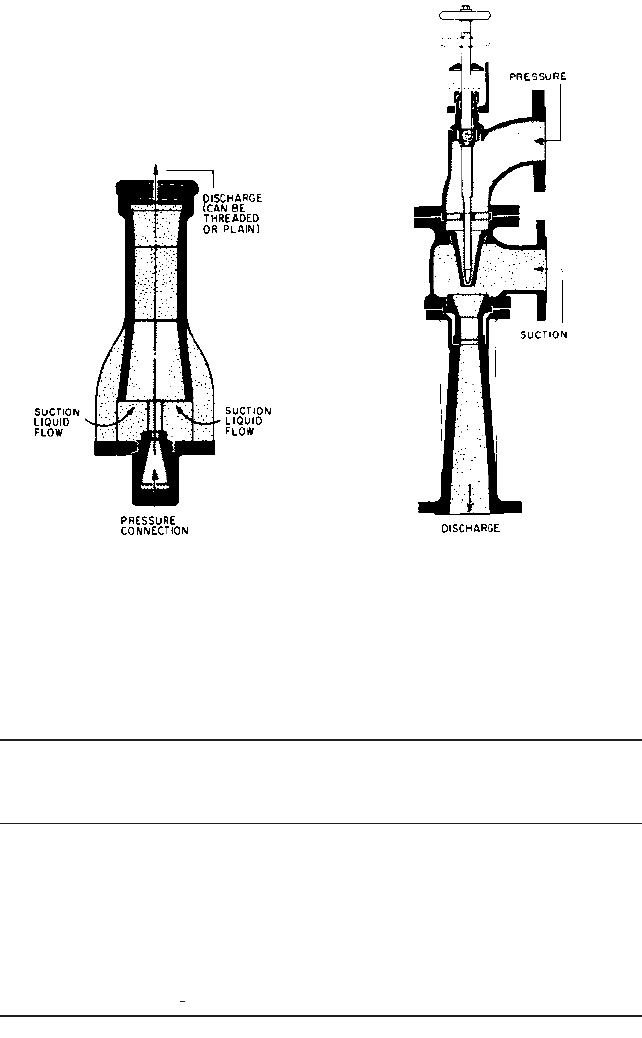
4.2 JET PUMP APPLICATIONS 4.35
FIGURE 11 Proportioning eductor (Schutte and
Koerting)
FIGURE 10 Tank mixing eductor (Schutte and
Koerting)
TABLE 3 Operating pressures and flow rates
—
proportioning eductor
Naphtha/ Sour
copper kerosene/
Motive liquid/ chloride Hydrocarbon/ Gasoline/ Gasoline/ kerosene
suction fluid slurry hydrocarbon slurry water slurry
Pressure, lb/in
2
(bar)
gage
Motive 165 (11.4) 295 (20.3) 170 (11.7) 75 (5.2) 146 (10.1)
Suction 40 (2.8) 5 (0.3) 75 (5.2) 50 (3.4) 60 (4.1)
Discharge 75 (5.2) 10 (0.7) 100 (6.9) 50 (3.4) 70 (4.8)
Flow, gpm (m
3
/h)
Motive 30 (6.8) 10 (2.3) 90 (20.4) 170 (38.6) 482 (109.5)
Suction 20 (4.5) 58 (13.2) 74 (16.8) 42 (9.5) 700 (159.0)
Discharge 50 (11.4) 68 (15.4) 164 (37.2) 212 (48.1) 1182 (268.5)
Eductor size, in (mm) 1 (38.1) 3 (76.2) 4 (102) 4 (102) 6 (152)
Source: Schutte & Koerting.
1
2

4.36 CHAPTER FOUR
FIGURE 12 Sand and mud eductor (Schutte and Koerting)
TABLE 4 Relative capacities (flow rates) of sand and mud eductors
Capacity of standard 3-in (76.2-mm) eductor
Operating water pressure, lb/in
2
(bar) gage 40.0 (2.8) 50.0 (3.4) 60.0 (4.1)
Total motive fluid, gpm (m
3
/h) 69.5 (15.8) 77.5 (17.6) 85.0 (19.3)
Net suction fluid, gpm (m
3
/h) 30.0 (6.8) 34.5 (7.8) 38.5 (8.7)
Maximum discharge head, ft (m) 22.0 (6.7) 26.0 (7.9) 32.0 (9.8)
Relative capacities of standard sizes
Size eductor, in (mm) 1 (38.1) 2 (63.5) 3 (76.2) 4 (102) 5 (127) 6 (152)
Capacity ratio 0.29 0.62 1.00 1.85 2.80 3.80
Source: Schutte and Koerting.
1
2
1
2
sand, mud, slime, or other material not easily handled by other eductors. With this type
of eductor, the bottom of the pressure chamber is fitted with a ring of agitating nozzles
that stirs the material in which the jet is submerged to allow maximum entrainment. Rel-
ative capacities for this type of eductor are shown in Table 4, which is used in the same
manner as Table 1. The required suction flow is divided by the suction capacity selected
from Table 4 under the appropriate motive pressure.This value is the capacity ratio. From
the table, select the eductor by choosing the next highest capacity ratio. Actual flow rates
are then determined by multiplying the values in the table by the capacity ratio of the
eductor selected. Maximum discharge head is read from the table.
SOLIDS-HANDLING EDUCTORS Figure 13 illustrates a specific type of eductor called a hop-
per eductor, made for handling slurries or dry solids in granular form and used for eject-
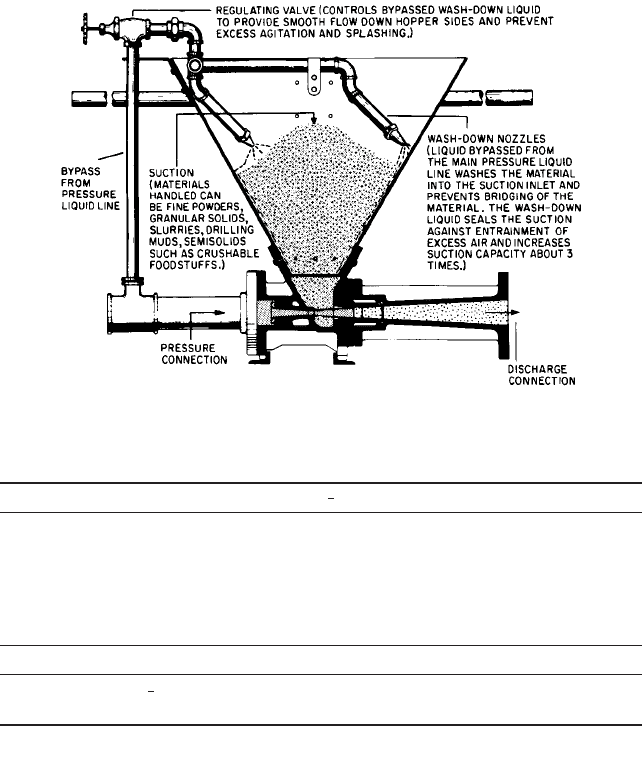
4.2 JET PUMP APPLICATIONS 4.37
TABLE 5 Relative capacities (flow rates) of hopper eductors
Capacity of standard 1 -in (38-mm) eductor
Operating water pressure, lb/in
2
(bar) 30 (2.1) 40 (2.8) 50 (3.4) 60 (4.1)
gage
Suction capacity, ft
3
/h (m
3
/h) 13 (0.37) 36 (1.0) 72 (2.0) 90 (2.5)
Maximum discharge pressure, lb/in
2
14 (1.0) 17 (1.1) 18 (1.2) 20 (1.4)
(bar) gage
Motive water consumption, gpm (m
3
/h)
a
35 (7.9) 40 (9.1) 45 (10.2) 50 (11.4)
Relative capacities of standard sizes
Size, in (mm) 1 (38.1) 2 (50.8) 3 (76.2) 4 (102) 6 (152)
Capacity ratio 1.00 1.60 3.50 6.00 18.00
a
Based on using approximately 10% motive water through washdown nozzles.
Source: Schutte and Koerting
1
2
1
2
FIGURE 13 Hopper eductor (Schutte and Koerting)
ing sludges from tank bottoms, pumping sand from filter beds, and washing or conveying
granular materials.Typical construction is cast iron with hardened steel nozzle and throat
bushings. In operation, the washdown nozzles are adjusted to provide smooth flow down
the hopper sides, thus preventing bridging of the material being handled and also seal-
ing the eductor suction against excess quantities of air. Without this seal, the capacities
shown in Table 5 should be divided by approximately 3. Table 6 shows typical materials
handled by this eductor and their bulk density. Use of the capacity table for hopper educ-
tors is similar to use of Tables 1 and 4, except the suction quantities required are
expressed in cubic feet (cubic meters). Capacity ratio is determined by dividing the value
in the table into the required suction flow, and the next largest size eductor is selected.
Another type of solids-handling eductor is illustrated in Figure 14.This annular-orifice
eductor is used where the material being handled tends to agglomerate and gum up when
wetted and has been used successfully for handling and mixing hard-to-wet solids. In this

4.38 CHAPTER FOUR
TABLE 6 Typical materials handled by hopper eductors
Material Approx. bulk density, lb/ft
3
(kg/m
3
)
Borax 50
—
55 (800
—
880)
Charcoal 18
—
28 (290
—
450)
Diatomaceous earth 10
—
20 (160
—
320)
Lime, pebble 56 (900)
Lime, powdered 32
—
40 (510
—
640)
Fly ash 35
—
40 (560
—
640)
Mash 60
—
65 (960
—
1040)
Rosin 67 (1070)
Salt, granulated 45
—
51 (720
—
820)
Salt, rock 70
—
80 (1120
—
1280)
Sand, damp 75
—
85 (1200
—
1360)
Sand, dry 90
—
100 (1440
—
1600)
Sawdust, dry 13 (210)
Soda ash, light 20
—
35 (320
—
560)
Sodium nitrate, dry 80 (1280)
Sulfur, powdered 50
—
60 (800
—
960)
Wheat 48 (770)
Zinc oxide, powdered, dry 10
—
35 (160
—
560)
Source: Schutte and Koerting.
unit, intimate mixing occurs in the throat, and the device is virtually clogproof. Normally
this unit is installed directly over the tank into which the mixture is discharged. Table 7
shows capacities for this type of unit.
Capacity Table 7 is similar to Table 5, and the selection method is the same as dis-
cussed previously.
MULTINOZZLE EDUCTORS Figure 15 illustrates an annular multinozzle eductor designed for
special applications where the suction fluid contains solids or semisolids. It is used pri-
marily for large flows at low discharge heads. Because these units have relatively large
air-handling capacities, they are well suited for priming large pumps, such as dredging
pumps, where air pockets can cause these pumps to lose their prime. These eductors are
designed by using the basic equations for head ratio. The appropriate efficiency factor is
selected from Figure 2, and the volumetric flow ratio is calculated. Figure 4 is used to size
the eductor after discharge flow has been determined.
DEEP-WELL EDUCTORS The eductor illustrated in Figure 16 is typical of those used in con-
junction with a mechanical pump for commercial and residential water supply from a
deep well. The eductor is used to lift water from a level below barometric height up to a
level where the suction of the motive pump at the surface can lift the water the remain-
ing distance.
In operation, the eductor is fitted with hoses connected to the suction and discharge of
the motive pump and dropped into the well casing. An initial prime is required, which is
maintained by the foot valve at the suction of the eductor. When the surface pump is acti-
vated, pressure water through the eductor entrains water from the well, lifting it high
enough to enable the mechanical pump to carry it to the surface.A bypass valve at the sur-
face diverts the suction quantity to a receiving tank.
Capacities of these units depend on the depth of the well and the centrifugal pump.The
standard commercial unit has 1-in (25-mm) pressure and 1 -in (32-mm) discharge con-
nections and is available with a variety of nozzle and diffuser combinations for use with
standard centrifugal pumps at varying depths. The following example illustrates how to
calculate this type of unit.
1
4

4.2 JET PUMP APPLICATIONS 4.39
FIGURE 14 Annual eductor (Schutte and Koerting)
EXAMPLE
4 A centrifugal pump with a capacity of 100 gpm (22.7 m
3
/h) at a total dis-
charge head of 150 ft (45.7 m) and requiring 10 ft (3.05 m) NPSH is available to oper-
ate an eductor to pump water at 50 ft (15.2 m) below grade. Find the quantity of water
that can be delivered at 60 lb/in
2
(4.1 bar) gage (see Figure 17).
Solution The available operating head is 138.6 ft 50 ft frictional loss (42.2
15.2 frictional loss). As a first assumption, the frictional loss is ignored and the head
ratio is 188.6/40.83 4.62 (57.4/12.38 4.62). From Figure 2 at NPSH 33.6 ft (10.24
m), e 0.9 and
(from Eqs. 5 and 6)
With Q
R
fixed at 100 gpm (22.7 m
3
/h),
R
w
R
q
0.924.62 1 0.934
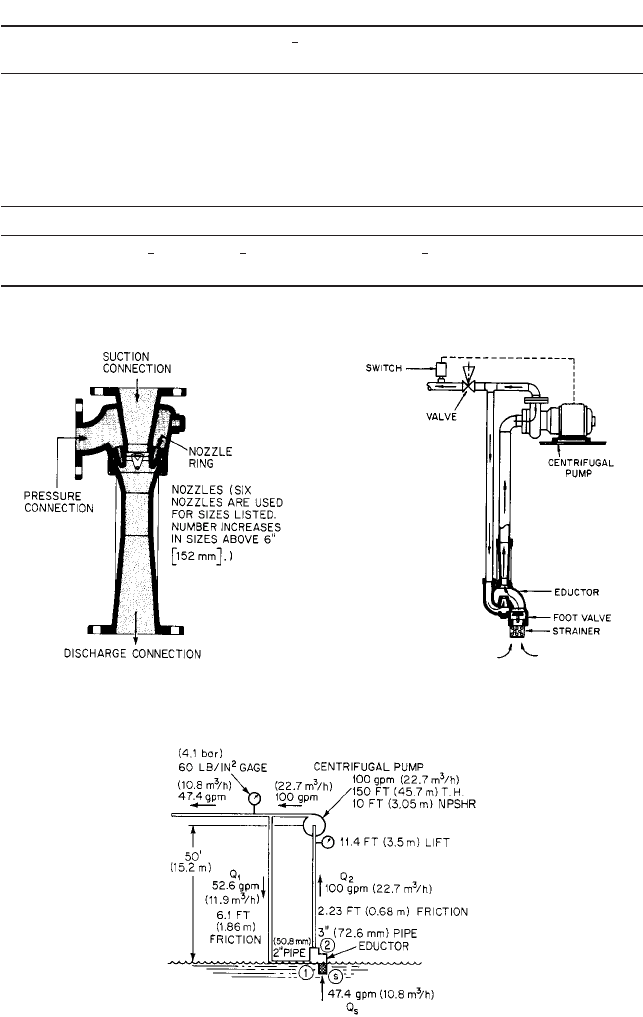
4.40 CHAPTER FOUR
TABLE 7 Relative capacities (flow rates) of annual eductors
Capacity of standard 1 -in (38.1-mm) mixing eductor,
5 lb/in
2
(0.34 bar) gage discharge pressure
Motive pressure, 30 (2.1) 40 (2.8) 60 (4.1) 80 (5.5) 100 (6.9)
lb/in
2
(bar) gage
Entrainment, ft
3
/h 2.6 (0.07) 7.1 (0.20) 17.9 (0.51) 22.0 (0.62) 23.8 (0.67)
(m
3
/h)
Motive flow, gpm 12.7 (2.88) 14.6 (3.31) 17.9 (4.06) 20.7 (4.70) 23.1 (5.24)
(m
3
/h)
Relative capacities of standard sizes
Size, in (mm) 1 (31.8) 1 (38.1) 2 (50.8) 2 (63.5) 3 (76.2) 4 (102)
Capacity ratio 0.62 1.00 1.43 2.86 4.76 8.80
Source: Schutte and Koerting.
1
2
1
2
1
4
1
2
FIGURE 15 Multinozzle eductor (Schutte and
Koerting)
FIGURE 16 Centrifugal-jet pump combination
FIGURE 17 Centrifugal-jet pump for Example 4

4.2 JET PUMP APPLICATIONS 4.41
in USCS units
in SI units
The motive line size is now chosen by selecting a reasonable velocity and frictional loss.
Choosing a 2-in (51-mm) pipe size, velocity is 5.57 ft/s (1.70 m/s) and frictional loss is
6.1 ftH
2
O (1.86 mH
2
O). The revised operating head becomes 188.6 6.1 182.5 ft
(57.4 1.86 55.6 m) and
in USCS units
in SI units
then Q
1
100/1.9 52.6 gpm (22.7/1.9 11.9 m
3
/h). (This value is close enough so that
a third trial is not necessary.) The suction flow that can be delivered is then
in USCS units
in SI units
PRIMING EDUCTORS
—
WATER-JET EXHAUSTERS Eductors are often used as priming devices for
mechanical pumps. In this application, the eductor is used to remove air rather than
water. Liquid jets are not well suited for pumping noncondensables; therefore, the capac-
ities are low. However, the volume being primed is usually small, and so the low capacity
is not a factor. When larger volumes are involved, such as condenser water boxes, it is more
feasible to use an exhauster. The water-jet eductor of Figure 6 is converted to a water-jet
exhauster by replacing the jet nozzle with a solid-cone spray nozzle. Evacuating rates and
capacity tables for such a unit are shown in Figure 18 and Table 8. Eductors have approx-
imately one-fifth the air-handling capacities of water-jet exhausters when supplied with
similar motive quantities and pressures.
EXAMPLE 5 From Figure 18 and Table 8, determine size and water consumption to
exhaust 15 standard ft
3
/min (0.42 m
3
/min) of air at 20 inHg (508 mmHg) abs discharg-
ing to atmosphere using 60 lb/in
2
(4.14 bar) gage motive water at 80°F (27°C).
Solution Enter Figure 18 at 80°F (27°C) (1); read horizontally to the suction pressure
20 inHg (508 mmHg) abs (2); project vertical line to 60 lb/in
2
(4.14 bar) gage motive
pressure (3); project a horizontal line for the capacity of a 1-in (25-mm) exhauster (4);
divide desired flow by the capacity of a 1-in (25-mm) unit, which is 1.9 standard ft
3
/min,
(0.054 m
3
/min), to find capacity ratio: 15/1.9 7.9 (0.42/0.054 7.9).
The capacity ratio table shows that a 3-in (76-mm) exhauster with a capacity ratio
of 9.0 is required. The motive water quantity from Table 8 is 86 gpm (19.5 m
3
/h). Note:
Table 8 gives water consumption at 15 inHg (381 mmHg) abs; because flow varies as the
square of pressure differential across the nozzle, the exact flow is obtained as follows:
Nozzle upstream pressure:
in USGS units
in SI units
Nozzle downstream pressure:
in USCS units 20 inHg abs a
14.7 lb>in
2
30 inHg
b 9.8 lb>in
2
abs
4.14 1.01 5.15 bar abs
60 14.7 74.7 lb>in
2
abs
22.7 11.9 10.8 m
3
>h
100 52.6 47.4 gpm
R
q
0.9255.6>12.38 1 0.9
R
q
0.92182.5>40.83 1 0.9
Q
1
22.7
1.934
11.7 m
3
>h
Q
1
100
1 R
q
100
1.934
51.7 gpm
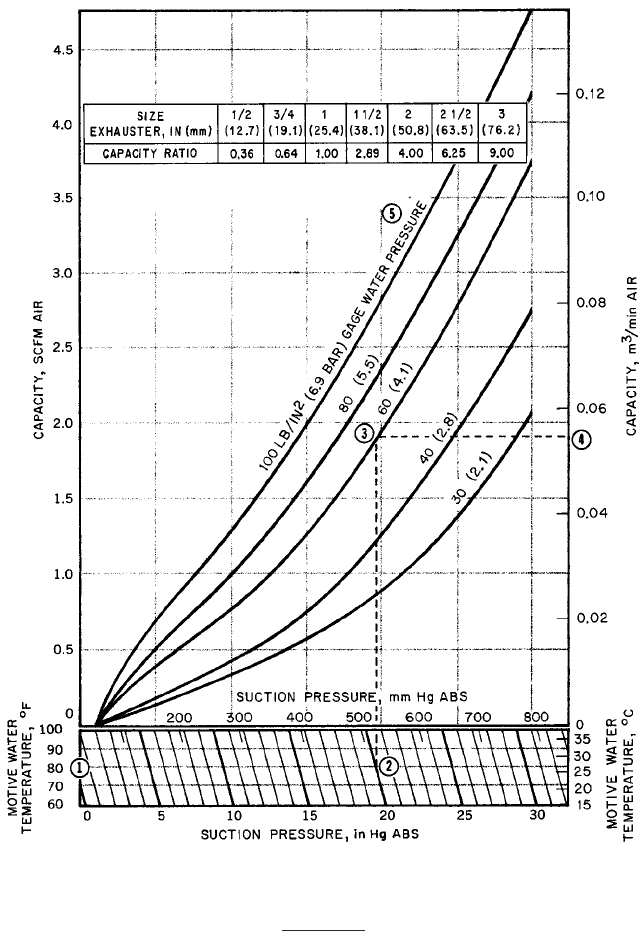
4.42 CHAPTER FOUR
FIGURE 18 Capacity curve of water-jet exhausters (Schutte and Koerting)
in SI units
Operating differential:
in USCS units
in SI units 5.15 0.67 4.48 bar
74.7 9.8 64.9 lb>in
2
508 mmHg abs a
1.01 bar
762 mmHg
b 0.67 bar abs
